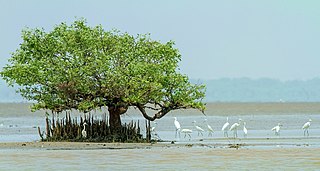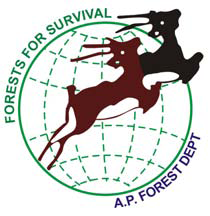
The Krishna River is a river in the Deccan plateau and is the third-longest river in India, after the Ganges and Godavari. It is also the fourth-largest in terms of water inflows and river basin area in India, after the Ganges, Indus and Godavari. The river, also called Krishnaveni, is 1,400 kilometres (870 mi) long and its length in Maharashtra is 282 kilometres. It is a major source of irrigation in the Indian states of Maharashtra, Karnataka, Telangana and Andhra Pradesh.

The fishing cat is a medium-sized wild cat of South and Southeast Asia. Since 2016, it is listed as Vulnerable on the IUCN Red List. Fishing cat populations are threatened by destruction of wetlands and have declined severely over the last decade. The fishing cat lives foremost in the vicinity of wetlands, along rivers, streams, oxbow lakes, in swamps, and mangroves.

The Eastern Ghats are a discontinuous range of mountains along India's eastern coast. The Eastern Ghats pass through the states of Odisha and Andhra Pradesh to Tamil Nadu by, passing parts of Karnataka and Telangana on the way. They are eroded and cut through by four major rivers of peninsular India, the Mahanadi, Godavari, Krishna and Kaveri. Sitamma Konda is the highest point in both Andhra Pradesh and the Eastern Ghats at 1,680 metres (5,510 ft). The Biligiriranga Hills in Karnataka are the tallest hill range in the Eastern Ghats, with many peaks above 1500 m in height.

Coastal Andhra or Kostandhra is a geographic region in the Indian state of Andhra Pradesh. Vijayawada is the largest city in this region. Region share borders with Uttarandhra, Rayalaseema and Telangana. It was part of Madras State before 1953 and Andhra State from 1953 to 1956. According to the 2011 census, it has an area of 91,915 square kilometres (35,489 sq mi) which is 57.99% of the total state area and a population of 34,193,868 which is 69.20% of Andhra Pradesh state population. This area includes the coastal districts of Andhra Pradesh on the Circar Coast between the Eastern Ghats and the Bay of Bengal, from the northern border with Odisha to Rayalaseema in the south.

The East Deccan dry evergreen forests is an ecoregion of southeastern India. The ecoregion includes the coastal region behind the Coromandel Coast on the Bay of Bengal, between the Eastern Ghats and the sea. It covers eastern Tamil Nadu, part of Puducherry and south eastern Andhra Pradesh.

Pulicat Lake is the second largest brackish water lagoon in India,, measuring 759 square kilometres (293 sq mi). A major part of the lagoon lies in the Tirupati district of Andhra Pradesh. The lagoon is one of three important wetlands that attracts northeast monsoon rain clouds during the October to December season. The lagoon comprises the following regions: Pulicat Lake, Marshy/Wetland Land Region (AP), Venadu Reserve Forest (AP), and Pernadu Reserve Forest (AP). The lagoon was cut across in the middle by the Sriharikota Link Road, which divided the water body into lagoon and marshy land. The lagoon encompasses the Pulicat Lake Bird Sanctuary. The barrier island of Sriharikota separates the lagoon from the Bay of Bengal and is home to the Satish Dhawan Space Centre.
Point Calimere Wildlife and Bird Sanctuary is a protected area in Tamil Nadu, South India, covering 21.47 km2 (8.29 sq mi) along the Palk Strait where it meets the Bay of Bengal at Point Calimere at the southeastern tip of Nagapattinam District. It was created in 1967 for the conservation of the blackbuck and also hosts large congregations of waterbirds, especially greater flamingos. It has been classified as an Important Bird Area.

Coringa Wildlife Sanctuary is an estuary situated near Kakinada in Andhra Pradesh, India. It is the third largest stretch of mangrove forests in India with 24 mangrove tree species and more than 120 bird species. It is home to the critically endangered white-backed vulture and the long billed vulture. Mangroves are a group of trees and shrubs that live in the coastal intertidal zone, with a dense tangle of prop roots that make the trees appear to be standing on stilts above the water. This tangle of roots allows the trees to handle the daily rise and fall of tides; hence, the mangrove forest gets flooded at least twice per day. The roots also slow the movement of tidal waters, causing sediments to settle out of the water and build up the muddy bottom.

The Godavari–Krishna mangroves are a mangrove ecoregion of India's eastern coast.

Kaundinya Wildlife Sanctuary is a wildlife sanctuary and an elephant reserve situated in Andhra Pradesh, India. It is the only sanctuary in Andhra Pradesh with a population of Asian elephants, which migrated after 200 years from neighbouring regions.

Andhra Pradesh Forest Department is one of the administrative divisions of Government of Andhra Pradesh. It is headed by the Principal Chief Conservator of Forests, Head of Forest Force. The primary function of this department is protection, conservation and management of forests in the Andhra Pradesh State. The Forest Department is organized into 12 territorial circles and 43 divisions. In addition, one Senior Officer of the rank of Deputy Conservator of Forests functions as Planning and Extension Officer in each district.

The Geography of South India comprises the diverse topological and climatic patterns of South India. South India is a peninsula in the shape of a vast inverted triangle, bounded on the west by the Arabian Sea, on the east by the Bay of Bengal and on the north by the Vindhya and Satpura ranges.

Manjira wildlife sanctuary is a wildlife sanctuary and reservoir located in the Sangareddy district of Telangana State, India. Originally a crocodile sanctuary developed to protect the vulnerable species mugger crocodile, today it is home to more than 70 species of birds. The reservoir, located in the sanctuary, provides drinking water to Hyderabad and Secundarabad.

The state of Andhra Pradesh is considered one of the rich 123 bio-diversified states in India. Natural vegetation (flora) and animal life (fauna) depend mainly on climate, relief, and soil. Krishna and Godavari are the two largest rivers flowing through the state. The Andhra Pradesh Forest Department deals with protection, conservation and management of forests.
Sri Penusila Narasimha Wildlife Sanctuary is a famous 1030.85 km² Protected area in Nellore District of Andhra Pradesh state in South India. It comprises a unique and endangered forest type viz.

The coastline of Andhra Pradesh is located on the southeastern coast of the Indian Peninsula in the Bay of Bengal and is part of the Northern Circars. With a length of 975 km, it has the second longest coastline in India after Gujarat. The coastal corridor boasts several ports, harbors, vast stretches of sandy beaches, wildlife and bird sanctuaries, as well as fresh water lakes and estuaries.

Kolleru Bird Sanctuary is a sanctuary in Andhra Pradesh, India. It covers 673 square kilometers. It was established in November 1999, under the Wildlife Protection Act of 1972. The sanctuary protects part of the Kolleru Lake wetland, which gained Ramsar Convention for International importance in 2002.

Char Kukri-Mukri Wildlife Sanctuary is a wildlife sanctuary in southern Charfession Upazila of Bangladesh, located on Char Kukri Mukri island in the Bay of Bengal. The area of the sanctuary is 40 ha, and is elongated in shape. It is 130 km from Barisal town in the gangetic delta on the mouth of Meghna river. It is also called Charfasson wildlife sanctuary. Most part of the sanctuary is submerged twice in a day due to high tide and is covered with dense mangrove vegetation. The soil type is clay.

Gundla Brahmeshwaram Wildlife Sanctuary is a wildlife sanctuary located in the Nallamala Forest in Kurnool district of Andhra Pradesh, India. The northern part of the sanctuary is an important part of the Nagarjunsagar-Srisailam Tiger Reserve.


























